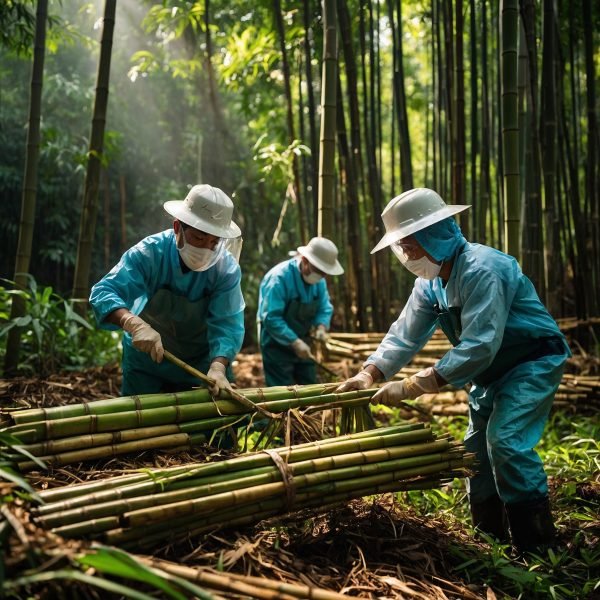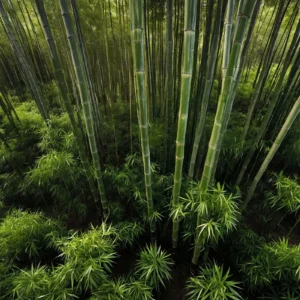Bamboo has been celebrated for centuries as a versatile and eco-friendly material. From ancient Asian architecture to contemporary sustainable living solutions, this fast-growing grass offers numerous benefits that make it an ideal choice for environmentally conscious individuals and communities. In this comprehensive blog post, we will explore the many facets of bamboo, including its environmental benefits, various uses, and its role in promoting a sustainable lifestyle.
Introduction to Bamboo
Bamboo is a type of grass that belongs to the family Poaceae. It is renowned for its rapid growth and versatility. With over 1,400 species spread across the globe, bamboo is primarily found in tropical and subtropical regions, although some species thrive in temperate climates. This plant’s incredible growth rate, which can reach up to 35 inches per day, makes it one of the fastest-growing plants on earth.
The Growth Cycle of Bamboo
One of the most striking characteristics of bamboo is its growth cycle. Unlike hardwood trees that take decades to mature, bamboo can be harvested in as little as three to five years. This rapid growth cycle is due to the plant’s unique rhizome-dependent system, which allows it to regenerate quickly after being cut. This sustainable harvesting process ensures a continuous supply without causing significant environmental degradation.
Environmental Benefits of Bamboo
Bamboo offers a multitude of environmental benefits, making it a key player in the quest for sustainable living.
Carbon Sequestration
Bamboo is highly efficient in capturing carbon dioxide from the atmosphere. A single hectare of bamboo can sequester up to 62 tons of CO2 annually, significantly more than an equivalent area of hardwood forest. This capability helps mitigate climate change by reducing the amount of greenhouse gases in the atmosphere.
Soil Erosion Control
The extensive root system of bamboo helps stabilize soil, preventing erosion. This is particularly beneficial in regions prone to landslides and flooding. Bamboo roots bind the soil together, reducing the impact of heavy rains and protecting the landscape from erosion.
Water Conservation
Bamboo requires relatively little water compared to other crops. Its efficient water use and ability to grow in diverse conditions make it an excellent plant for regions facing water scarcity. Furthermore, bamboo cultivation does not typically require chemical fertilizers or pesticides, reducing the potential for water pollution.
Biodiversity Enhancement
Bamboo forests support a diverse range of wildlife, providing habitat and food for various species. In many parts of the world, bamboo ecosystems are crucial for the survival of endangered animals, such as the giant panda in China.
Bamboo in Sustainable Living
Bamboo’s environmental benefits are complemented by its versatility and utility in sustainable living. Here are some ways bamboo contributes to eco-friendly practices and products:
Construction and Architecture
Bamboo has been used as a building material for thousands of years. Its strength and flexibility make it an excellent alternative to traditional construction materials like steel and concrete. Modern bamboo architecture showcases innovative designs that are both aesthetically pleasing and environmentally friendly.
Structural Strength
Despite its lightweight nature, bamboo is incredibly strong. Certain species of bamboo have a tensile strength that rivals steel, making it suitable for constructing robust structures. Bamboo’s natural resilience also means it can withstand extreme weather conditions, including earthquakes and hurricanes.
Sustainable Housing
Bamboo’s rapid growth and renewability make it an ideal material for sustainable housing projects. Bamboo homes are not only environmentally friendly but also cost-effective. They provide natural insulation, reducing the need for artificial heating and cooling systems, which in turn lowers energy consumption.
Furniture and Home Decor
Bamboo furniture and home decor items are gaining popularity due to their durability and eco-friendly attributes. From chairs and tables to flooring and wall panels, bamboo products offer a sustainable alternative to traditional wood furnishings.
Durability and Aesthetics
Bamboo furniture is known for its strength and longevity. Its unique grain and natural finish provide a rustic yet elegant look that complements various interior design styles. Additionally, bamboo’s resistance to swelling and shrinking makes it suitable for different climates.
Eco-Friendly Production
The production process for bamboo furniture typically involves fewer chemicals and less energy compared to conventional wood processing. Many manufacturers also use non-toxic adhesives and finishes, further reducing the environmental impact.
Clothing and Textiles
Bamboo fibers are used to create soft, breathable, and biodegradable textiles. Bamboo fabric is naturally antibacterial, moisture-wicking, and UV-resistant, making it an excellent choice for clothing, bedding, and towels.
Sustainable Fashion
The fashion industry is increasingly turning to bamboo as a sustainable alternative to conventional fabrics. Bamboo clothing is not only comfortable and stylish but also eco-friendly. The cultivation of bamboo for textiles requires fewer resources, and the resulting fabric is biodegradable, reducing landfill waste.
Ethical Production
Many bamboo textile manufacturers adhere to ethical production practices, ensuring fair wages and safe working conditions for workers. This commitment to social responsibility adds another layer of sustainability to bamboo products.
Kitchenware and Utensils
Bamboo kitchenware, including cutting boards, utensils, and serving trays, is a sustainable alternative to plastic and hardwood products. These items are lightweight, durable, and biodegradable, making them perfect for eco-conscious consumers.
Health Benefits
Bamboo kitchenware is naturally antimicrobial, reducing the risk of bacterial contamination. This makes it a healthier option for food preparation and storage. Additionally, bamboo utensils do not react with acidic foods, preserving the natural flavors of your dishes.
Zero-Waste Lifestyle
Adopting bamboo kitchenware is a step towards a zero-waste lifestyle. These products are biodegradable and compostable, meaning they won’t contribute to landfill waste at the end of their life cycle. By choosing bamboo, you are reducing your reliance on single-use plastics and promoting a circular economy.
Bamboo in Agriculture
Beyond its use in construction and consumer products, bamboo plays a significant role in sustainable agriculture.
Agroforestry Systems
Bamboo can be integrated into agroforestry systems, where it is grown alongside crops and livestock. This practice enhances biodiversity, improves soil health, and provides additional income streams for farmers.
Crop Diversification
By incorporating bamboo into their farming systems, farmers can diversify their crops and reduce the risk of crop failure. Bamboo’s fast growth and multiple uses make it a valuable addition to any agricultural enterprise.
Soil Improvement
Bamboo’s extensive root system helps improve soil structure and fertility. The decomposing leaves and stems add organic matter to the soil, enhancing its nutrient content and water-holding capacity.
Renewable Energy
Bamboo biomass can be converted into renewable energy through various processes, including gasification, pyrolysis, and combustion. Bamboo-based bioenergy is a sustainable alternative to fossil fuels, providing a clean and renewable source of power.
Bioenergy Production
Bamboo’s high cellulose content makes it an excellent feedstock for bioenergy production. It can be used to produce bioethanol, biogas, and biochar, all of which have lower carbon footprints compared to traditional fossil fuels.
Environmental Impact
Using bamboo for bioenergy reduces the need for deforestation and minimizes greenhouse gas emissions. It also provides a renewable energy source that can help reduce dependence on non-renewable resources.
Challenges and Considerations
While bamboo offers numerous benefits, there are some challenges and considerations to keep in mind when promoting its use.
Monoculture Plantations
The establishment of large-scale bamboo monoculture plantations can lead to biodiversity loss and soil degradation. It is essential to implement sustainable farming practices that promote biodiversity and soil health.
Biodiversity Conservation
To avoid the negative impacts of monoculture, bamboo cultivation should be integrated with other crops and native vegetation. This approach helps maintain ecological balance and supports a diverse range of species.
Sustainable Harvesting
Sustainable harvesting practices are crucial to ensure the long-term viability of bamboo resources. Overharvesting can deplete bamboo stands and negatively impact the environment. Proper management and harvesting techniques are essential to maintain a sustainable supply.
Market Demand and Economic Viability
The success of bamboo as a sustainable resource depends on market demand and economic viability. Ensuring a steady demand for bamboo products and providing fair compensation to producers are critical for the industry’s growth.
Market Development
Efforts should be made to develop and expand markets for bamboo products. This includes raising awareness about the benefits of bamboo and promoting its use in various industries. Government policies and incentives can also play a role in supporting market development.
Fair Trade Practices
Adopting fair trade practices ensures that bamboo producers receive fair wages and work in safe conditions. This ethical approach helps build a sustainable bamboo industry that benefits both producers and consumers.
Research and Development
Continued research and development are necessary to unlock the full potential of bamboo. Innovations in cultivation, processing, and product development can enhance the sustainability and efficiency of bamboo use.
Technological Advancements
Investing in technological advancements can improve the efficiency of bamboo processing and production. This includes developing new methods for extracting bamboo fibers, improving the durability of bamboo products, and creating innovative bamboo-based materials.
Knowledge Sharing
Sharing knowledge and best practices among bamboo producers, researchers, and industry stakeholders is essential for the growth of the bamboo sector. Collaboration and information exchange can lead to new insights and solutions for sustainable bamboo use.
Conclusion
Bamboo is a remarkable renewable resource with the potential to transform sustainable living. Its rapid growth, environmental benefits, and versatility make it an ideal choice for a wide range of applications, from construction and furniture to textiles and agriculture. By embracing bamboo, we can reduce our environmental footprint, support biodiversity, and promote a more sustainable and resilient future.
As we move towards a more eco-conscious lifestyle, incorporating bamboo into our daily lives is a step in the right direction. Whether you choose bamboo products for your home, support sustainable bamboo farming, or advocate for bamboo-based solutions in your community, every action counts in the journey towards a greener planet.
Bamboo’s potential is vast, and with continued research, innovation, and responsible practices, we can harness its power to create a more sustainable and harmonious world.





